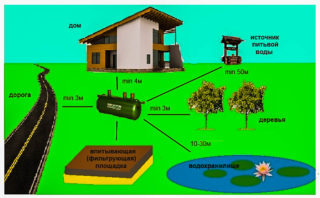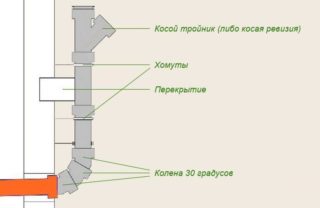When erecting a building, a common sewer pipe is installed at the stage of laying the foundation. When the building is ready, internal highways and a septic tank are connected to it. If you do not install this section of the pipeline on time, it will take a lot of effort to drill a hole for the drainage outlet from the house under the foundation.
Design stages
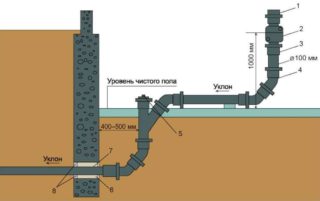
The project of a sewerage system in a private house is created even before the start of laying the pipeline. It should take into account the following points:
- is it possible to connect the sewage system to the central communication complex;
- they will live in the house permanently or temporarily;
- how many residents and likely guests are planned;
- Are the rooms with sewer drains far apart?
If it is not supposed to be connected to the central system, choose what type of treatment plant will be installed: cesspool, septic tank, biological treatment plant.
When building a new house, they design the outlet of the sewer pipe from the house to the septic tank at the same time as the building plan. This allows all catchment points to be positioned closer to each other, which contributes to a simple and efficient network with a single drain pipe.
For a private cottage of a large area, an exception can be made and a system of two risers can be installed, but the exits must be located at a distance of at least half a meter.
Rules for withdrawing sewage from a private house
It is also required to take into account other requirements of SNIPs and SanPiNs:
- The distance from the sewer under the overlap of the base of the house to the storage tank is 5–10 m.
- It is not allowed to arrange a cesspool at a distance of less than two meters from a neighboring site and 30 meters from a well or a well (for sandy soil, at least 50 meters).
- The slope is created so that the drop for each meter of the pipeline is approximately 3 cm.
- The depth of the sewer line is below the freezing point of the earth. If this cannot be done, the pipe sections will have to be insulated or equipped with electric heating.
The rules also take into account the installation of a revision well with a hatch, which must be at least three meters away from the building.
A sewage treatment plant, requiring periodic pumping out with sewage equipment, is erected in such a way that it is convenient to drive up to it.
For the gravity flow of sewage, the storage tank is located lower than the level of the building, or pumping equipment is installed.
Installation of the sewer line under the foundation of the house must be performed according to certain rules. The pipes are assembled by inserting them into each other. Special rubber gaskets are installed in the sockets, the joints are thoroughly cleaned of dirt and covered with liquid soap or special lubricating compounds.
Preparatory work
You will also need:
- sleeves with a cross section larger than the diameter of the pipeline;
- fitting elements (tees, elbows with plugs, couplings);
- adapters;
- fasteners.
For sealing, a special gun is used, into which a cylinder filled with silicone is inserted. Other tools are selected depending on how you create the outlet and piping.
Methods for removing the sewer depending on the type of foundation
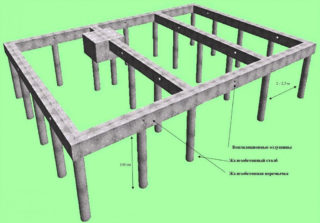
The choice of method determines the type of foundation of the building. With a competent approach, you can remove the sewer main from an already rebuilt house.
Column and pile foundation
It is easiest to remove the sewage system from a private house with a similar base to the street. Columns or piles allow the installation of communication networks after the construction of the building. During the work, they make sure that the ditch is dug at the maximum possible distance from the columns. The close location of the trench will weaken the earth around them, and reduce their bearing performance.
To connect to the sewer, you will need to make a hole in the floor slab for the outlet of the main pipe.
When installing the pipeline under the columnar foundation, take into account that the space under the building is not heated. Insulation of communications is carried out with heat-insulating materials or they equip additional heating by means of an electric cable.
Monolithic slab
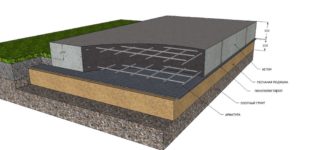
Installation of communication lines is real only before pouring a monolithic foundation. When installing sewer pipes, you will need sleeves. They will not allow the slab base to overload the pipeline, as well as protect against damage to the main networks in the slab when pouring concrete.
In the event of an accident, the liners will allow you to quickly remove the damaged part and put a new piece of pipe in its place.
The communication network, which is protected by the sleeves, is installed directly in the trench, where the earth is then poured and concrete mortar is poured.
Tape base
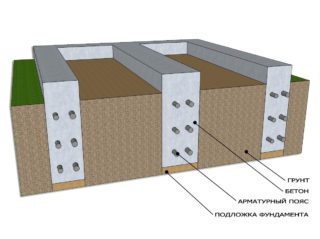
Conclusion in such a foundation can be made both during the construction of the building and in an existing house. In the first version, the process is carried out during the pouring of the base. In the second, the method depends on how deeply the foundation is installed.
It is possible to withdraw the sewer through the deep strip foundation in this way:
- A hole is cut in the formwork. A sleeve from a metal pipe is inserted into it.
- The part is fixed and poured with concrete.
- A sewer pipe is brought into the resulting case.
For work, you will need a hammer drill and a grinder.
If the base is not deep, you can dig a dig using a shovel or a drill. To do this, the future pipeline is mounted in a trench, the bottom of which is below the level of soil freezing directly under the base. To protect communications from overloads, a piece of metal pipe is put on in advance.
Use of directional drilling
Making communications exit through the base to the street is not an easy job. The application of the directional drilling method will help to facilitate it. This technique is suitable for a significant thickness of the strip base and involves punching a deviated well to the bottom of the building foundation. The channel is required to bring out communication networks.
Using the technique, you need to correctly calculate the drilling angle. As a result, the lower boundary of the channel should dock with the end of the pipe, which is installed when pouring the base or when drilling a hole in the tape.
So that during drilling operations the direction does not change, a long drill is used and the walls of the well are periodically suspended. A sleeve from a piece of pipe is then placed in the channel. The sewage main will enter into it, connecting the internal and external sewerage systems.
With the right approach and observance of technological nuances, it is possible to equip the outlet of the sewer line even after the construction of the building.

